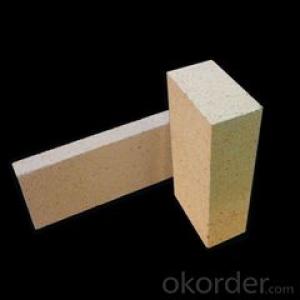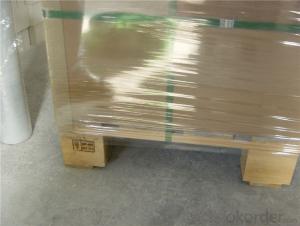Insulating Fire Brick - GJM Mullite Insulation Brick GJM-26
- Loading Port:
- Shanghai
- Payment Terms:
- TT OR LC
- Min Order Qty:
- 10 m.t.
- Supply Capability:
- 1000 m.t./month
OKorder Service Pledge
OKorder Financial Service
You Might Also Like
Specifications
mullite insulation brick
1. Low thermal conductivity
2.High hot compressive strength
3.Perfect Energy saving
Light weight mullite insulation furnace bricks refractory for sale
Advantage
1. Low thermal conductivity
2.High hot compressive strength
3.Perfect Energy saving
Description:
Lightweight mullite kiln bricks refractory for sale are made from good quality and superpure raw materials, with strictly classified fillings according to their grades. These fillings can form a uniform pore structure after burnt during the process of manufacture. Each grade of products has unique design to meet different thermal, physical and chomical demands.
Application:
Mullite insulation furnace bricks refractory material can be used in linings or heat-insulating materials of the industries, such as, ethylene pyrolysis furnaces, tubular furnaces, reforming furnaces of synthetic ammonia, gas generators and high-temperature shullte kilns, etc
Mullite Insulation furnace refractory material can be used as working lining, where contact with flames directly. This kind of brick can save the kiln energy very much
- Q: Can insulating fire bricks be used in the construction of boilers?
- Indeed, the application of insulating fire bricks is possible in the construction of boilers. Comprised of lightweight materials with exceptional thermal insulation properties, these bricks prove to be apt for deployment in high-temperature scenarios, including boilers. Their utilization aids in diminishing heat dissipation and augmenting energy efficacy by impeding heat leakage from the boiler. Moreover, they exhibit remarkable resilience against thermal shock and can endure extreme temperatures, thereby establishing themselves as a dependable alternative for constructing boilers.
- Q: Can insulating fire bricks be used for insulation in cold storage facilities?
- Yes, insulating fire bricks can be used for insulation in cold storage facilities. Insulating fire bricks are made from lightweight materials with high insulating properties, such as ceramic or refractory fibers. They have low thermal conductivity, which means they can effectively prevent heat transfer and maintain a stable temperature inside the cold storage facility. The bricks are also resistant to extreme cold temperatures and can withstand thermal shock, making them suitable for use in cold storage applications. Additionally, insulating fire bricks are durable and can provide long-term insulation, reducing energy consumption and maintaining the desired temperature for storing perishable goods.
- Q: Can insulating fire bricks be used in the insulation of boilers?
- Indeed, the utilization of insulating fire bricks is possible for the insulation of boilers. These fire bricks are engineered to endure elevated temperatures and exhibit remarkable efficiency in preventing heat transfer. With their low thermal conductivity, they aid in minimizing heat dissipation from the boiler, thereby enhancing its energy efficiency holistically. Moreover, due to their lightweight composition and ease of installation, insulating fire bricks are an optimal selection for boiler insulation.
- Q: Can insulating fire bricks be used in cement plants?
- Yes, insulating fire bricks can be used in cement plants. Insulating fire bricks are designed to withstand high temperatures and are commonly used in industries that require thermal insulation. In cement plants, they can be used in various applications such as lining kilns, furnaces, and other high-temperature equipment. These bricks help in reducing heat loss, improving energy efficiency, and ensuring consistent and controlled temperatures in the cement production process. Additionally, insulating fire bricks are lightweight and have low thermal conductivity, making them an ideal choice for insulating applications in cement plants.
- Q: Can insulating fire bricks be used in the construction of blast furnaces?
- Yes, insulating fire bricks can be used in the construction of blast furnaces. These bricks are made from lightweight materials with high thermal resistance, which makes them highly suitable for insulating the inner lining of blast furnaces. They help to minimize heat loss and maintain the high temperatures required for efficient and effective operation of the blast furnace, making them an essential component in its construction.
- Q: How do insulating fire bricks help improve the efficiency of heat recovery systems?
- Insulating fire bricks play a crucial role in improving the efficiency of heat recovery systems in several ways. Firstly, these bricks are made from high-quality insulating materials such as ceramic fiber, which have excellent thermal properties. This means that they have a low thermal conductivity, preventing heat from escaping or being wasted. By using insulating fire bricks as lining materials in heat recovery systems, the heat exchange process becomes more efficient as less heat is lost to the surroundings. Secondly, insulating fire bricks help to reduce heat transfer through conduction. They act as a barrier between the hot and cold sides of the system, minimizing heat loss through direct contact. This insulation effect allows the heat recovery system to maintain a higher temperature on the hot side, maximizing the temperature difference and thus enhancing the heat transfer rate. Additionally, insulating fire bricks are lightweight and have low heat storage capabilities. This means that they require less energy to heat up and cool down, resulting in faster response times of the heat recovery system. This quick response enables the system to adapt rapidly to changes in heat generation or demand, improving its overall efficiency. Moreover, the use of insulating fire bricks as refractory materials in heat recovery systems helps to reduce energy consumption. Since these bricks can withstand high temperatures without cracking or deforming, they contribute to the longevity of the system, reducing the need for frequent repairs or replacements. This leads to lower maintenance costs and less downtime, ultimately improving the overall energy efficiency of the heat recovery system. In summary, insulating fire bricks enhance the efficiency of heat recovery systems by providing excellent thermal insulation, reducing heat loss through conduction, enabling quick response times, and minimizing energy consumption. Their use as lining materials significantly improves the heat transfer process, resulting in more effective heat recovery and utilization.
- Q: Are insulating fire bricks resistant to moisture absorption?
- Indeed, insulating fire bricks exhibit resistance to moisture absorption. These bricks have been meticulously engineered to possess a low porosity, thereby thwarting any moisture absorption. The manufacturing procedure entails the utilization of top-notch refractory materials that possess the capability to endure extreme temperatures, while simultaneously resisting the detrimental impact of moisture. Consequently, insulating fire bricks emerge as an exemplary option for scenarios necessitating moisture resistance, such as kilns, furnaces, and other environments characterized by elevated temperatures.
- Q: How do insulating fire bricks affect the overall noise insulation of a building?
- Insulating fire bricks can significantly enhance the noise insulation of a building. These bricks have excellent sound-absorbing properties due to their high density and ability to dampen sound vibrations. By reducing the transmission of airborne and impact noises, insulating fire bricks help create a quieter and more peaceful indoor environment.
- Q: Are insulating fire bricks resistant to insects and rodents?
- Yes, insulating fire bricks are generally resistant to insects and rodents due to their dense and solid construction, which makes it difficult for pests to penetrate or damage them.
- Q: Can insulating fire bricks be used for chimney lining?
- Yes, insulating fire bricks can be used for chimney lining. Insulating fire bricks are specifically designed to withstand high temperatures and are excellent at retaining heat. They have a low thermal conductivity which helps to prevent heat loss and improve the efficiency of the chimney. Additionally, insulating fire bricks are resistant to cracking and spalling, making them a durable option for chimney lining. However, it is important to ensure that the insulating fire bricks used are suitable for the specific type of chimney and comply with local building codes and regulations.
Send your message to us
Insulating Fire Brick - GJM Mullite Insulation Brick GJM-26
- Loading Port:
- Shanghai
- Payment Terms:
- TT OR LC
- Min Order Qty:
- 10 m.t.
- Supply Capability:
- 1000 m.t./month
OKorder Service Pledge
OKorder Financial Service
Similar products
Hot products
Hot Searches
Related keywords























